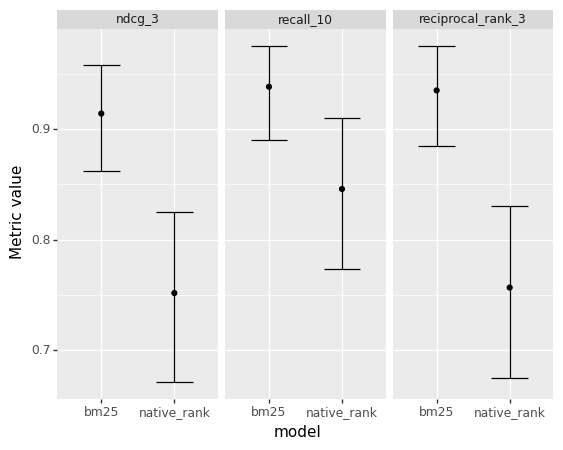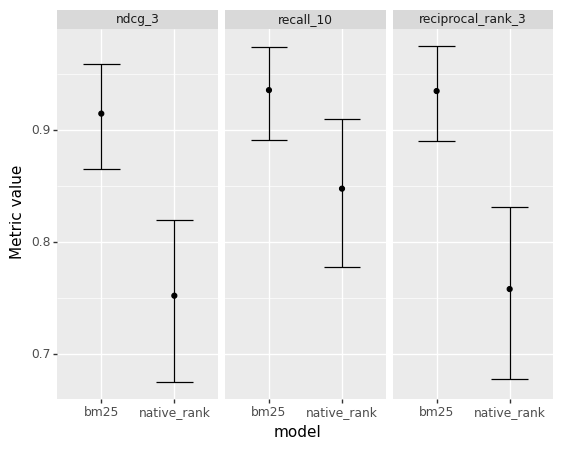from learntorank.passage import create_basic_search_package
app_package = create_basic_search_package()IR evaluation metrics with uncertainty estimates
When working with search engine apps, be it a text search or a recommendation system, part of the job is doing experiments around components such as ranking functions and deciding which experiments deliver the best result.
This tutorial builds a text search app with Vespa, feeds a sample of the passage ranking dataset to the app, and evaluates two ranking functions across three different metrics. In addition to return point estimates of the evaluation metrics, we compute confidence intervals as illustrated in the plot below. Measuring uncertainty around the metric estimates gives us a better sense of how significant is the impact of our changes in the application.

The code and the data used in this end-to-end tutorial are available and can be reproduced in a Jupyter Notebook.
Create the Vespa application package
Create a Vespa application package to perform passage ranking experiments using the create_basic_search_package.
We can inspect how the Vespa search definition file looks like:
print(app_package.schema.schema_to_text)schema PassageRanking {
document PassageRanking {
field doc_id type string {
indexing: attribute | summary
}
field text type string {
indexing: index | summary
index: enable-bm25
}
}
fieldset default {
fields: text
}
rank-profile bm25 {
first-phase {
expression: bm25(text)
}
summary-features {
bm25(text)
}
}
rank-profile native_rank {
first-phase {
expression: nativeRank(text)
}
}
}In this tutorial, we are going to compare two ranking functions. One is based on NativeRank, and the other is based on BM25.
Deploy the application
Deploy the application package in a Docker container for local development. Alternatively, it is possible to deploy the application package to Vespa Cloud.
from vespa.deployment import VespaDocker
vespa_docker = VespaDocker()
app = vespa_docker.deploy(application_package=app_package)Waiting for configuration server, 0/300 seconds...
Waiting for configuration server, 5/300 seconds...
Waiting for application status, 0/300 seconds...
Waiting for application status, 5/300 seconds...
Waiting for application status, 10/300 seconds...
Waiting for application status, 15/300 seconds...
Waiting for application status, 20/300 seconds...
Finished deployment.Once the deployment is finished, we can interact with the deployed application through the app variable.
Get sample data
We can load passage ranking sample data with PassageData.load. By default, it will download pre-generated sample data.
from learntorank.passage import PassageData
data = PassageData.load()dataPassageData(corpus, train_qrels, train_queries, dev_qrels, dev_queries)data.summaryNumber of documents: 1000
Number of train queries: 100
Number of train relevance judgments: 100
Number of dev queries: 100
Number of dev relevance judgments: 100Feed the application
Get the document corpus in a DataFrame format.
corpus_df = data.get_corpus()
corpus_df.head()| doc_id | text | |
|---|---|---|
| 0 | 5954248 | Why GameStop is excited for Dragon Age: Inquis... |
| 1 | 7290700 | metaplasia definition: 1. abnormal change of o... |
| 2 | 5465518 | Candice Net Worth. According to the report of ... |
| 3 | 3100518 | Under the Base Closure Act, March AFB was down... |
| 4 | 3207764 | There are a number of career opportunities for... |
Feed the data to the deployed application.
responses = app.feed_df(df=corpus_df, include_id=True, id_field="doc_id")Successful documents fed: 1000/1000.
Batch progress: 1/1.We can also check the number of successfully fed documents through the responses status code:
sum([response.status_code == 200 for response in responses])1000Query the application
Get the dev set queries in a DataFrame format.
dev_queries_df = data.get_queries(type="dev")
dev_queries_df.head()| query_id | query | |
|---|---|---|
| 0 | 1101971 | why say the sky is the limit |
| 1 | 712898 | what is an cvc in radiology |
| 2 | 154469 | dmv california how long does it take to get id |
| 3 | 930015 | what's an epigraph |
| 4 | 860085 | what is va tax |
Get the first query text to use as an example when querying our passage search application.
sample_query = dev_queries_df.loc[0, "query"]
sample_query'why say the sky is the limit'Query with QueryModel
Create the bm25 QueryModel, which uses Vespa’s weakAnd operator to match documents relevant to the query and use the bm25 rank-profile that we defined in the application package above to rank the documents.
from learntorank.query import QueryModel, WeakAnd, Ranking
bm25_query_model = QueryModel(
name="bm25",
match_phase=WeakAnd(hits=100),
ranking=Ranking(name="bm25")
)Once a QueryModel is specified, we can use it to query our application.
from learntorank.query import send_query
from pprint import pprint
response = send_query(
app=app,
query=sample_query,
query_model=bm25_query_model
)
pprint(response.hits[0:2])[{'fields': {'doc_id': '7407715',
'documentid': 'id:PassageRanking:PassageRanking::7407715',
'sddocname': 'PassageRanking',
'summaryfeatures': {'bm25(text)': 11.979235042476953,
'vespa.summaryFeatures.cached': 0.0},
'text': 'The Sky is the Limit also known as TSITL is a global '
'effort designed to influence, motivate and inspire '
'people all over the world to achieve their goals and '
'dreams in life. TSITL’s collaborative community on '
'social media provides you with a vast archive of '
'motivational pictures/quotes/videos.'},
'id': 'id:PassageRanking:PassageRanking::7407715',
'relevance': 11.979235042476953,
'source': 'PassageRanking_content'},
{'fields': {'doc_id': '84721',
'documentid': 'id:PassageRanking:PassageRanking::84721',
'sddocname': 'PassageRanking',
'summaryfeatures': {'bm25(text)': 11.310323797415357,
'vespa.summaryFeatures.cached': 0.0},
'text': 'Sky Customer Service 0870 280 2564. Use the Sky contact '
'number to get in contact with the Sky customer services '
'team to speak to a representative about your Sky TV, Sky '
'Internet or Sky telephone services. The Sky customer '
'Services team is operational between 8:30am and 11:30pm '
'seven days a week.'},
'id': 'id:PassageRanking:PassageRanking::84721',
'relevance': 11.310323797415357,
'source': 'PassageRanking_content'}]Query with Vespa Query Language
We can also translate the query created with the QueryModel into the Vespa Query Language (YQL) by setting debug_request=True:
response = send_query(
app=app,
query = sample_query,
query_model=bm25_query_model,
debug_request=True
)
yql_body = response.request_body
pprint(yql_body){'ranking': {'listFeatures': 'false', 'profile': 'bm25'},
'yql': 'select * from sources * where ({targetHits: 100}weakAnd(default '
'contains "why", default contains "say", default contains "the", '
'default contains "sky", default contains "is", default contains '
'"the", default contains "limit"));'}We can use Vespa YQL directly via the body parameter:
yql_response = send_query(app=app, body=yql_body)
pprint(yql_response.hits[0:2])[{'fields': {'doc_id': '7407715',
'documentid': 'id:PassageRanking:PassageRanking::7407715',
'sddocname': 'PassageRanking',
'summaryfeatures': {'bm25(text)': 11.979235042476953,
'vespa.summaryFeatures.cached': 0.0},
'text': 'The Sky is the Limit also known as TSITL is a global '
'effort designed to influence, motivate and inspire '
'people all over the world to achieve their goals and '
'dreams in life. TSITL’s collaborative community on '
'social media provides you with a vast archive of '
'motivational pictures/quotes/videos.'},
'id': 'id:PassageRanking:PassageRanking::7407715',
'relevance': 11.979235042476953,
'source': 'PassageRanking_content'},
{'fields': {'doc_id': '84721',
'documentid': 'id:PassageRanking:PassageRanking::84721',
'sddocname': 'PassageRanking',
'summaryfeatures': {'bm25(text)': 11.310323797415357,
'vespa.summaryFeatures.cached': 0.0},
'text': 'Sky Customer Service 0870 280 2564. Use the Sky contact '
'number to get in contact with the Sky customer services '
'team to speak to a representative about your Sky TV, Sky '
'Internet or Sky telephone services. The Sky customer '
'Services team is operational between 8:30am and 11:30pm '
'seven days a week.'},
'id': 'id:PassageRanking:PassageRanking::84721',
'relevance': 11.310323797415357,
'source': 'PassageRanking_content'}]Evaluate query models
In this section, we want to evaluate and compare the bm25_query_model defined above with the native_query_model defined below:
native_query_model = QueryModel(
name="native_rank",
match_phase=WeakAnd(hits=100),
ranking=Ranking(name="native_rank")
)We specify three metrics to evaluate the models.
from learntorank.evaluation import (
Recall,
ReciprocalRank,
NormalizedDiscountedCumulativeGain
)
metrics = [
Recall(at=10),
ReciprocalRank(at=3),
NormalizedDiscountedCumulativeGain(at=3)
]Point estimates
It is straightforward to obtain point estimates of the evaluation metrics for each query model being compared. In this case, we computed the mean and the standard deviation for each of the metrics.
from learntorank.evaluation import evaluate
evaluation = evaluate(
app=app,
labeled_data=data.get_labels(type="dev"),
eval_metrics=metrics,
query_model=[native_query_model, bm25_query_model],
id_field="doc_id",
aggregators=["mean", "std"]
)evaluation| model | bm25 | native_rank | |
|---|---|---|---|
| recall_10 | mean | 0.935833 | 0.845833 |
| std | 0.215444 | 0.342749 | |
| reciprocal_rank_3 | mean | 0.935000 | 0.755000 |
| std | 0.231977 | 0.394587 | |
| ndcg_3 | mean | 0.912839 | 0.749504 |
| std | 0.242272 | 0.381792 |
Given the nature of the data distribution of the metrics described above, it is not trivial to compute a confidence interval from the mean and the standard deviation computed above. In the next section, we solve this by using bootstrap sampling on a per query metric evaluation.
Uncertainty estimates
Instead of returning aggregated point estimates, we can also compute the metrics per query by setting per_query=True. This gives us more granular information on the distribution function of the metrics.
evaluation_per_query = evaluate(
app=app,
labeled_data=data.get_labels(type="dev"),
eval_metrics=metrics,
query_model=[native_query_model, bm25_query_model],
id_field="doc_id",
per_query=True
)evaluation_per_query.head()| model | query_id | recall_10 | reciprocal_rank_3 | ndcg_3 | |
|---|---|---|---|---|---|
| 0 | native_rank | 1101971 | 1.0 | 1.0 | 1.0 |
| 1 | native_rank | 712898 | 0.0 | 0.0 | 0.0 |
| 2 | native_rank | 154469 | 1.0 | 0.0 | 0.0 |
| 3 | native_rank | 930015 | 1.0 | 1.0 | 1.0 |
| 4 | native_rank | 860085 | 0.0 | 0.0 | 0.0 |
We then created a function that uses the evaluation per query data and computes uncertainty estimates via bootstrap sampling.
from learntorank.stats import compute_evaluation_estimates
estimates = compute_evaluation_estimates(
df = evaluation_per_query
)estimates| metric | model | low | median | high | |
|---|---|---|---|---|---|
| 0 | ndcg_3 | bm25 | 0.865279 | 0.914863 | 0.958766 |
| 1 | ndcg_3 | native_rank | 0.675220 | 0.752400 | 0.820318 |
| 2 | recall_10 | bm25 | 0.891667 | 0.935833 | 0.974187 |
| 3 | recall_10 | native_rank | 0.778312 | 0.847917 | 0.910000 |
| 4 | reciprocal_rank_3 | bm25 | 0.890000 | 0.935000 | 0.975000 |
| 5 | reciprocal_rank_3 | native_rank | 0.678333 | 0.758333 | 0.831667 |
We can then create plots based on this data to make it easier to judge the magnitude of the differences between ranking functions.
from plotnine import *
print((ggplot(estimates) +
geom_point(aes("model", "median")) +
geom_errorbar(aes(x="model", ymin="low",ymax="high")) +
facet_wrap("metric") + labs(y="Metric value")
))
Cleanup the environment
vespa_docker.container.stop(timeout=600)
vespa_docker.container.remove()